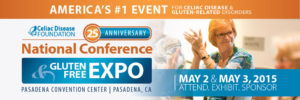I have been looking forward to the Celiac Disease Foundation National Conference and Gluten-Free Expo since I first heard of it in the days following Miss E's diagnosis. Disclosures first, I attended the Conference and Expo on a media pass courtesy of the Celiac Disease Foundation. As always, Go Gluten Freely articles are full of my own, honest opinions.

While product expos are a fabulous way to discover new gluten-free food options (read the Go Gluten Freely review of the Celiac Disease Foundation Expo here), I was desperate to learn more about celiac disease during the educational sessions. The weeks after Miss E was diagnosed, I spent many late nights scouring the Celiac Disease Foundation's information-rich website, celiac.org, for guidance on how to keep my daughter healthy and safe. My husband teased me about the glow of my phone well past midnight night after night, as I kept up with my obsession. Living celiac-safe is a steep learning curve, and I wanted to know everything... yesterday. Six months after Miss E's diagnosis, I sat in the expo hall and had a refresher in some of the basics from those early weeks AND updates on new research. Here are some of the highlights...
Special Tribute
Dr. Francisco Leon is the Co-founder and CEO/CMO, Celimmune, a pharmaceutical company developing gluten stool tests to measure gluten consumption in celiac patients - similar to insulin testing in diabetics. While I have mixed feelings about the application of some of the drugs in development that would allow celiacs to eat a gluten-containing diet, I can easily see the benefits of this one. As an asymptomatic celiac, the ability to test for accidental gluten exposure when eating out could help me identify and avoid restaurants that are not celiac-safe. My top takeaway from Dr. Leon... "If you do the diet correctly, you'll never develop celiac lymphoma." This statement alone is enough motivation to keep Miss E and me on our no-cheat gluten-free diet for life.
Celiac Disease 101:Going Gluten-Free
Dr. Joseph Murray spouted off a list of symptoms that may indicate celiac disease: iron deficiency (5-8% of adults with unexplained iron deficiency have celiac disease), low B-12, dental enamel defects, fractures from bone softening. Other folks who are "at risk" include those with other autoimmune disorders, such as type one diabetes, Sjorgren's syndrome, thyroid disease, lupus, rheumatoid arthritis, and Addison's disease. The message to those with these symptoms or other autoimmune diseases or those with celiac relatives is... get the (simple) blood test!
Regarding intestinal healing post celiac diagnosis, Dr. Murray recommends an optional re-biopsy in 1-2 years and follow-up blood tests. A Finish study indicated almost 100% of patients were healed in eight years, and his own study indicated approximately ⅔ of patients were healed in five years. In his practice, he generally sees patients essentially without symptoms at one year and with healed intestines at three-four years. His advice... "don't think of yourself as having a disease at that point (three to four years post-diagnosis) ." More good news! Yes, we have to stick to the life-long diet, but as far as our bodies know, we are essentially healed.
A Balancing Act: Women's Health & Celiac Disease
For me, Dr. Sheila Crowe's session was the most anticipated part of the conference. She "married into" celiac disease and has a passion for her patients and education in the field. Interestingly, Dr. Crowe debunked the myth that celiac is mostly a woman's disease. The prevalence is equal in males and females, but men are underdiagnosed. She discussed fertility and pregnancy complications with celiac disease. Bottom line, women with celiac disease who are planning for pregnancy need a proper diagnosis, screening for vitamin D, iron, and other vitamin and mineral deficiencies, a healthy gluten-free diet, and folic acid. Her advice for children of celiac parents, retest blood every 3 years and watch for symptoms, provided a helpful guideline for CJ (my non-celiac son). She also supports gene testing, which in CJ's case could rule out celiac disease and avoid any future blood screening. Dr. Crowe echoed Dr. Murray's statement that vitamin D deficiency and thyroid disease can be red flags - again, get the test!
Dietician and Nutrition Panel
This was the most content-rich session. I could not keep up with all these ladies had to share, as is often the case when a dietitian is speaking.
Shelley Case, BSc RD, CDF Medical Advisory Board Member
- Malt vinegar is fermented, not distilled (distilling removes gluten), so it needs to be avoided.
- Licorice is 50% wheat.
- Buy gluten-free grains with a gluten-free claim on the label. Otherwise, the risk of cross-contamination from wheat is high.
- If you have a shared kitchen, provide separate: utensils, baking items, a sifter, wooden spoon, toaster, colander, and bread maker. I would add a cutting board and knife to this list.
- Nutritious flour alternatives:
- Legumes (lentils, peas...): high protein, high fiber, lower carbs, more vitamins & minerals than typical gluten-free flours
- Almond flour (Me: Bob's Red Mill has a delicious pancake recipe on the bag of their almond flour.)
- Include other (labeled) gluten-free grains: amaranth, millet, quinoa, sorghum, teff, buckwheat, and gluten-free oats in your diet.
- Choose iron-rich and calcium-rich foods.
- Many celiacs are initially lactose intolerant, as the intestines heal, you may be able to return to dairy. If you can go back on dairy, it's a better source of calcium than milk substitutes.

Schar went up ten notches in my eyes as a result of Dr. Lee's presentation and responses in the Q&A session. She is the mother of a son with celiac disease and has devoted herself to celiac dietary research and education. For a glowing review of Schar, you can visit the Gluten Free Girls' Celiac Disease Foundation Expo Product Review. For gluten-free living tips (recipes, travel, kids...), visit the Schar website. Dr. Lee shared two sobering statistics. One study showed that 81% of celiac patients had a weight gain in the two years following their celiac diagnosis. The average weight gain was 25 lbs. These are scary words to hear, sitting there newly diagnosed and already noticing that my jeans are getting tighter. Unfortunately, I fear my weight gain is due to more than just eating gluten-free cookies (much higher in fat and sugar than their gluten counterparts)... I have experienced a post-diagnosis, insatiable hunger, and may sadly gain 25 lbs on chia seeds and almonds.
More takeaways from Dr. Lee:
- The typical gluten-free diet is high in fat, low in good cards and fiber, and low in nutrients.
- You need a multivitamin, unless you have a good gluten-free dietary pattern.
- For breakfast, eat oatmeal rather than rice-based cereal.
- For lunch, eat a nutritious gluten-free grain (or even bread), instead of rice-based bread.
- Frito-Lay has a strategy of testing and labeling its current line of products that are already naturally gluten-free. When attending picnics and parties, it's nice to know Miss E can grab a bag of Cheetos "like the other kids" because the "gluten-free" label provides me peace of mind.
- Frito-Lay does not have a dedicated gluten-free facility. Dr. Pan explained how thoroughly they clean between production runs.
- Frito-Lay maintains two updated lists of its Gluten-Free Products and Products Not Containing Gluten Ingredients. Please read each list carefully, and make sure you are looking at the correct list.




